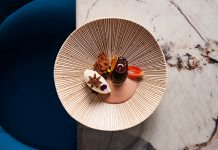In Melbourne’s bustling laneways, Lee Ho Fook adds to the flavour with inventive dishes conjured by Victor Liong. By Ethan Quill
Melbourne’s laneways have seen a revival of interest in the once quiet and derelict back alleys. The injection of activity into this network of walkways has resulted in life coursing through them as graffiti line the walls, and cafes and bars hum with business.
The idea of revitalising the laneways ― which grew out of Melbourne’s gridiron plan in 1837 for easy sale of land parcels ― was mooted in the 1980s to encourage life in the city after hours, something European cities seemed to do effectively.
By carving out space in the laneways, it attracted small businesses to set up, especially after the liquour licensing laws were made more flexible.
The key audience for many of the businesses along these pedestrian walkways are tourists, and the generation X and Y customers who are happy to spend for an interesting experience.
One of the most visited of these back alleys is the ACDC Lane, named in honour of the rock band that helped put Australian music on the map. Past the image of Angus Young and following the art on the walls to Duckboard Place, you’ll come across a red neon sign with a picture of a bespectacled chap over the doorway.
Lee Ho Fook sounds like it could be a medicine hall or a massage parlour, but for those in the know, it’s an innovative Chinese fusion restaurant set up by Sydney native Victor Liong. Originally established in Collingwood, in 2013, it moved to its current location two years later.
Liong’s work with Japanese, French and other modern cooking styles is infused into Chinese cuisine to serve up a mouthwatering and thought-provoking array of dishes that will surprise your palate, like many of the sights and sounds in the laneways.
He has since set up Lawyers, Guns and Money, serving classic Chinese breakfast fare in the legal district.
Is Lee Ho Fook’s food reflective of the melting pot that is Melbourne?
VICTOR LIONG: Lee Ho Fook for me is an avenue to express my classical and modernist training with the flavours that resonate with me from my childhood, it’s playful, thought out, interesting and I hope delicious, I feel we have carved our own notch into Melbourne’s exciting dining melting pot.
Originally I imagined the restaurant to be a fun and lively casual eatery that cooked tasty food and had a party vibe.
It has since grown into a quite serious restaurant with a diverse wine offering and a sharpened focus on precise cooking and creative use of quality local ingredients.
I’m very happy that the restaurant has grown organically and the team and my staff involved are constantly improving and polishing the product and it’s something I am very proud of.
In Melbourne’s competitive food culture, how are tastes shifting, and how often will menus have to be refreshed?
LIONG: Like all restaurants competing in Melbourne, it’s important to keep the product in the customer’s mind. I believe the menu should change periodically to reflect the season and the inspiration that is current in the creative mind of the chefs involved. Also, I believe that a restaurant should have standard hallmark dishes that represent the offering and provide a consistency of product for the customer to keep returning to. (Try the tea eggs, the Chinezza ― Chinese pizza ― the Kingfish with white fungus and burnt garlic.)
In terms of shifting tastes, there are more and more people travelling and exploring Asia and its surrounding countries, so their palates have had a preview of the levels of spice and intensity of flavour from dining experiences abroad. So, the use and balance of intense and vibrant seasonings can be actually tweaked to a more ‘authentic’ spectrum and the cooking can slowly start to reflect it’s original inspiration.
The creative process of changing the menu also helps create ‘new classic’ dishes that add another level to the dining experience and showcases where the restaurant is right now.
What are your sources of inspiration?
LIONG: We go through a variety of processes to arrive at the end product that makes the menu. Firstly, the chefs just write down ingredients they are inspired by from the season, the markets, and other dining experiences. Sometimes it’s texture or colour based. Then we think about obvious techniques to apply to make the dish work, we then also imagine any unconventional techniques or flavour combinations that arise and see if they somehow work with the initial ingredient. Then we test and see if the words on the whiteboard actually somehow manifest into a dish on the plate. We all eat it and give feedback. Sometimes it’s an instant success with minimal tweaking, sometimes they’re complete failures and it’s back to the drawing board. If the dish is a success in the kitchen it’s tested on the customers via the special’s menu, and if it proves popular to the customer it eventually makes it on the menu. It’s a long process and we always have dishes at varying stages of completion and testing, it’s also great fun and gets the team involved.
Sources of inspiration come from everywhere, the season we are in, sometimes seeing the colour and the texture of the garden or a landscape will inspire a dish, or travelling. The flavour profile of other cooks when they prepare staff meals and introduce dishes from their heritage is also a great inspiration. But mostly we draw from within each chef, we’re telling a story of the food that relates to us and how and why we cook, and that comes from a story within, and no one else can tell that story ― it’s a great internal exploration process.
What are the challenges facing the food industry?
LIONG: There is overfishing of our seas, and the focus on sustainable food production needs to be taken more seriously.
There needs to be a better regulatory measure in place for food additives in mass food production.
The unsustainable consumption of meat and the eventual need to find an alternative is a big issue.
The skills shortage across the industry needs to be addressed.
The customer’s perception on how much they pay for a meal and how much it costs to actually produce their dinner needs to be changed.
There are a lot of concerning issues that face the food industry and there are things being done slowly to address each of these issues, if people were more aware that the future of what you eat depends on these issues being properly addressed.
When it eventually becomes reality that there is no fish left in the sea, all the vegetables are pumped with antibiotics which in turn make us sick because the antibiotics we consume are no longer effective, and the only option is to eat seaweed and insects made by unskilled chefs, I’d hate to imagine that it could have been avoided if we all made a conscious effort today.






















